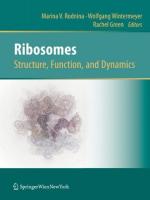|
This section contains 427 words (approx. 2 pages at 300 words per page) |

|
Some living organisms, such as bacteria, consist of a single cell and can be observed only under the microscope. Other organisms are multicellular and may be composed of billions of specialized cells. In each example, the cell is the basic unit of life. Throughout history, two major types of cells have evolved. The more primitive prokaryotic cell lacks a defined nucleus and specialized structures called organelles. Eukaryotic cells make up most of the multicellular plants and animals, including humans. They have organelles and a nucleus, which contains the genetic material of the cell and acts as a control center. Other organelles include lysosomes, Golgi apparatus, vacuoles, endoplasmic reticula, and mitochondria. One of the most numerous and important organelles within the cell is the ribosome. A growing bacteria cell may have 15,000 ribosomes, and a eukaryotic cell may contain many times more. Each ribosome is a small circular structure that...
|
This section contains 427 words (approx. 2 pages at 300 words per page) |

|


